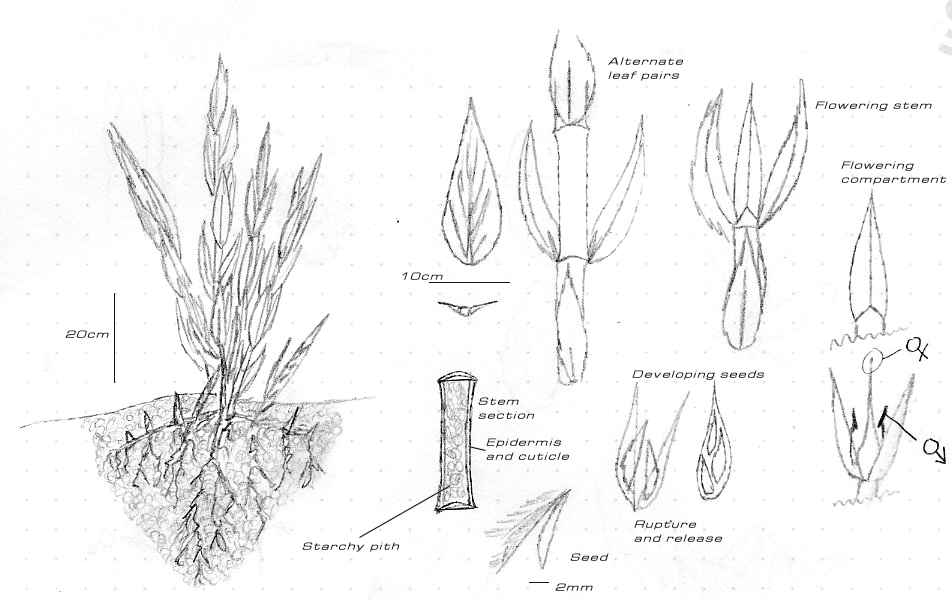

|
tRENORET AGRICULTURE: REYASH |
 |
|
Reyash is a principle crop of Trenoc agriculture, the perennial plantís starchy stem are harvested prior to flowering, and can harvested up to three times a year in warmer and wetter temperate regions. Reyash shares a lot of common morphology with Earthís grasses and bamboos, with compartmented stems filled with an edible starch rich pith, Each stem length sports a set of two narrow elliptical leaves which are set alternately against other stem leaf sprays when viewed down the stem. Each stem shoot sprouts from one of the laterally traveling roots, and can grow up to a metre tall before flowering. Flowering can occur as soon as 60 days after the shoot surfaces above the soil. The flowering compartment is a modified stem section which when ripe splits to firstly to reveal the plantís sex organs, and again secondly to release its downy seeds. Reyash is harvested generally three times a year, though in colder regions two crops may only be obtained a year, the first crop is the winterís and autumns growth after the summer cutting. The stems are cut at ground level before the flowering chambers develop too much, left later and the pith becomes too bitter to eat. The plant will rapidly regenerate from the base and subsequent cuttings are made as necessary as the stems begin to reach a flowering stage. Reyash enjoys a lot of moisture and warmth, and under these conditions will provide the greatest crops, however Reyash does not grow well in subtropical or tropical regions, as it requires a cold winter to stimulate spring growth, and also to encourage shoot formation on the roots. Reyash seed can easily be collected from allowing a crop to flower. In modern times the seed is collected by placing a thin horticultural fleece of the seeding crop, and the downy seed become trapped in the fleeceís fibres, the fleece is then cut up into strips and pegged to the ground where the seed will germinate and grow. In addition to this collection process the seed may need to be refrigerated to give better germination in warmer climates. Though Reyash is a perennial plant each individual clump will become less productive after five years or so, after this time the fields are then plowed to break up and reduce the clumps, and therefore restore productivity, other times the crop is burnt to the ground and the soil dug over and resown. Reyash has relatively few pests, though it is grazed upon by the larger herbivores (and is often grown as a fodder crop as consequence). The major problematic pests to the Reyash crop are a fungus like organism, which proliferates in the leaf axils and spoils the starch (Queykar) this particular pest is controlled by culturing the Reyash with a symbiotic bacterium that lives on the stems waxy cuticle and destroys any fungal infestation (bacterial spores are usually mixed with seed stock before sowing). There are a number of insect like pests which have been readily controlled by slight modifications of the symbiotic bacteria (developing larvae in the Reyash can not become sexually mature as the bacteria release an inhibitory compound in the surface cuticle). Though Reyash in its raw state is suitable for a fodder crop and can be used for rearing infant Trenoc, it is more commonly milled into coarse fragments, and the pith separated from the vegetable matter by use of large shallow water tanks, where the pith can be skimmed off the top, the process can be repeated many times to extract a very pure starchy pith. The purified pith can be dried and subsequently milled to yield a much finer flour, or be compressed in its wet state to create cakes of coarser pith which on cooking provide a rice like material.
|










